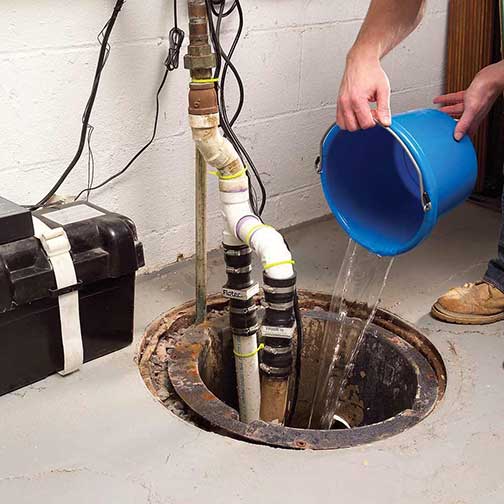Straightforward Methods for Cleaning a Sump Pump
Straightforward Methods for Cleaning a Sump Pump
Blog Article
How do you actually feel in relation to Steps to Cleaning Your Sump Pump Properly?

Sump pumps are critical elements in lots of homes, especially in locations susceptible to flooding or too much moisture. They assist stop water damage by efficiently getting rid of excess water from cellars or crawl spaces. Nevertheless, like any other appliance, sump pumps need regular upkeep to guarantee they operate efficiently when needed one of the most. Cleaning your sump pump is a crucial part of its maintenance, and recognizing just how to do it appropriately can save you from pricey fixings and prospective calamities.
Introduction
Maintaining a clean sump pump is crucial for its correct functioning and durability. Disregarding this necessary job can lead to clogs, breakdowns, and inevitably, water damage to your home. As a result, learning just how to clean up a sump pump is important for property owners that count on these tools to keep their cellars dry and protected.
Signs of a Dirty Sump Pump
Recognizing when your sump pump requires cleaning is essential for preventing prospective breakdowns. Some typical signs that suggest an unclean sump pump include weird sounds throughout procedure, minimized water circulation, and visible particles in the pit. If you discover any one of these symptoms, it's vital to clean your sump pump immediately to prevent any type of further concerns.
Planning for Cleansing
Prior to you begin cleaning your sump pump, it's important to take some safety preventative measures. Beginning by shutting off the power to the pump to stay clear of any type of electrical crashes. Furthermore, wear proper safety gear, such as handwear covers and safety glasses, to protect on your own from dust, debris, and prospective virus.
Understanding the Sump Pump
Before diving into the cleansing procedure, it's important to have a fundamental understanding of exactly how a sump pump works. Typically mounted in a pit or basin below the cellar floor, a sump pump consists of a number of essential elements, consisting of a pump, a float button, and a discharge pipe. When water collects in the pit, the float switch activates the pump, which after that pumps the water out with the discharge pipe, far from the structure's foundation.
Detailed Guide to Cleaning a Sump Pump
Shutting Off the Power
Begin by disconnecting the power supply to the sump pump to stop any type of accidents while cleaning.
Looking For Correct Performance
Prior to reinstalling the pump, carry out a fast test to make sure that the float switch triggers the pump properly. Pour some water into the sump pit and observe the pump's operation. If everything is functioning appropriately, you can rebuild the pump and reconnect the power supply.
Eliminating Debris and Dirt
Utilize a bucket or an inside story to get rid of any type of visible debris, dust, or debris from the sump pit. Dispose of the debris appropriately to stop it from obstructing the pump or the discharge pipeline.
Cleaning the Pump and Float Switch Over
Once the pit is free from debris, meticulously eliminate the pump from the pit. Evaluate the pump and the float button for any type of signs of damages or wear. Utilize a soft brush or fabric to cleanse the surface areas and eliminate any gathered grime.
Flushing the System
After cleaning up the pump and float button, flush the sump pit with tidy water to eliminate any remaining dust or sediment. This will certainly assist make sure that the pump operates smoothly and successfully.
Upkeep Tips to Keep Your Sump Pump Clean
In addition to routine cleaning, there are numerous maintenance suggestions you can comply with to maintain your sump pump in optimal problem:
Conclusion
Cleaning your sump pump is a crucial aspect of its maintenance and makes certain that it runs efficiently when you require it one of the most. By following the actions described in this guide and incorporating normal upkeep into your regimen, you can extend the life-span of your sump pump and protect your home from water damage.
6 STEPS ON HOW TO CLEAN A SUMP PUMP PROPERLY
UNDERSTANDING SUMP PUMPS
Your sump pump plays a crucial role in protecting your home by managing and removing excess water. It primarily functions as a “shield”, guarding your basement against the damaging effects of water accumulation. The pump is housed in a sump pit in the lowest part of your basement, and its job is to pump out any water that collects there.
During heavy rainfalls or when snow melts rapidly, water can infiltrate your basement, posing potential risks like flooding, structural damage, and harmful mold growth. Here, the sump pump springs into action, pumping out the intruding water and directing it away from your home.
SAFETY FIRST
Before cleaning, remember to prioritize safety. Disconnect the sump pump from the power source to prevent any accidental electric shocks. Also, wear sturdy gloves to protect your hands from any sharp or dirty components within the pump.
REMOVE THE SUMP PUMP
After ensuring your safety, the next step is to remove the sump pump from its pit. Doing this might require careful maneuvering as you don’t want to damage any pump components. Once removed, clean the sump pit to remove any accumulated debris or sludge.
INSPECT THE PUMP
Inspect the pump for any visible signs of wear or damage. Check the power cord, float switch, and impeller housing. If any components look worn out or damaged, consider replacing them to ensure optimal performance.
CLEAN THE PUMP
Thoroughly clean the pump with warm, soapy water. Make sure to rid it of any dirt, gravel, or other debris that might impede its performance. You can use a toothbrush to clean the small, hard-to-reach parts of the pump.
REINSTALL THE SUMP PUMP
Reinstall the pump into the sump pit Make sure it’s positioned correctly to remove the water effectively Once it’s back in place, reconnect it to the power source TEST THE PUMP
Finally, pour some water into the pit to ensure the pump works correctly. It should start automatically and begin pumping out the water; if it doesn’t, check the power source and the positioning of the pump.
Remember, while cleaning your sump pump is an essential part of home maintenance, hiring a professional plumber for a thorough inspection and cleaning at least once a year is also important. This will ensure that your pump is in optimal condition, ready to protect your home from potential water damage.
BEST PRACTICES FOR CLEANING SUMP PUMP DISCHARGE PIPES
Regular Inspection: Regularly inspect your discharge pipes, especially during heavy rainfall or snowmelt periods. Look for any signs of blockage or damage. Early detection of problems can prevent serious issues down the line. Periodic Cleaning: Over time, sediment and debris can accumulate in the discharge pipes, impeding the flow of water. Regular cleaning helps keep the pipes clear and functioning efficiently. You can use a high-pressure water jet to effectively clean the pipes. Insulation During Winter: In colder climates, discharge pipes can freeze, blocking the outflow of water. Protect your discharge pipes from freezing temperatures by insulating them with foam pipe insulation. This will ensure the sump pump can continue to discharge water even in freezing conditions. Proper Positioning: The discharge pipe should be positioned to direct water away from your home’s foundation. Improper positioning can lead to water seeping back into the basement. Ensure the pipe is long enough and angled correctly. Installation of a Check Valve: A check valve prevents water from flowing back into your sump pit after the pump has pushed it out. Installing a check valve helps maintain the efficiency of your sump pump and reduces the risk of flooding. Minimize Pipe Turns: Every curve or turn in the discharge pipe can decrease the efficiency of water flow. By minimizing turns and bends in your discharge pipe, you can increase the efficiency of your sump pump. https://www.fullspeedplumbing.com/how-to-clean-a-sump-pump-properly9999/

Do you enjoy reading up on ? Leave feedback further down. We would be glad to find out your reactions about this posting. Hoping that you come back again in the future. In case you enjoyed our blog entry if you please be sure to share it. We recognize the value of your readership.
Click Here Report this page